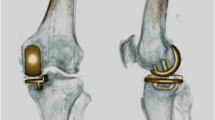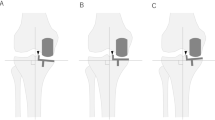Abstract
Purpose
The purpose of this study is to evaluate the risk of medial tibial cortical perforation in unicompartmental knee arthroplasty (UKA) due to peg positions on the tibial tray of the Persona Partial Knee (PPK).
Methods
Preoperative CT images of 60 patients and 60 osteoarthritic knees (30 male and 30 female patients) were used. A tibial multiplanar reconstruction (MPR) image was reconstructed in preoperative planning software, and the implant was placed in a virtual osteotomy plane. In addition to PPK, Zimmer Unicompartmental Knee (ZUK) and TRIBRID (TBD) were used for evaluation. The horizontal distances from the medial tibial cortex to the anterior and posterior pegs (APCD/PPCD, respectively) were measured under neutral, 3-degree varus, 3-degree valgus and 2 mm distal positions. The differences between implants under the same positions and between positions using the same implants were compared. The percentage of total cases with APCD/PPCD of less than 3 mm and the perforation risk rate were calculated.
Results
The APCD of PPK was significantly shorter at all positions except for the varus position of TBD. The PPCD of PPK was significantly shorter at all positions compared to ZUK and TBD. There were no cases with an APCD of less than 3 mm. Except for varus positions, the perforation risk rate of PPCD was significantly higher for PPK than the other two implants.
Conclusion
The posterior pegs of the PPK are located more medially than the other two implants, which may result in perforation of the medial tibial cortex during implantation. Surgeons should consider the risk involved in the type of implant used.





Similar content being viewed by others
References
Akagi M, Mori S, Nishimura S, Nishimura A, Asano T, Hamanishi C (2005) Variability of extraarticular tibial rotation references for total knee arthroplasty. Clin Orthop Relat Res 436:172–176
Argenson JN, Chevrol-BenkeddacheAubaniac YJM (2002) Modern unicompartmental knee arthroplasty with cement: a 3 to 10-year follow-up study. J Bone Jt Surg Am 84:2235–2239
Baur J, Zwicky L, Hirschmann MT, Ilchmann T, Clauss M (2015) Metal backed fixed-bearing unicondylar knee arthroplasties using minimal invasive surgery: a promising outcome analysis of 132 cases. BMC Musculoskelet Disord 16:177
Biswas D, Van Thiel GS, Wetters NG, Pack BJ, Berger RA, Della Valle CJ (2014) Medial unicompartmental knee arthroplasty in patients less than 55 years old: minimum of 2 years of follow-up. J Arthroplasty 29:101–105
Carpenter DP, Holmberg RR, Quartulli MJ, Barnes CL (2014) Tibial plateau coverage in UKA: a comparison of patient specific and off-the-shelf implants. J Arthroplasty 29:1694–1698
Epinette JA, Brunschweiler B, Mertl P, Mole D, Cazenave A, French Society for H et al (2012) Unicompartmental knee arthroplasty modes of failure: wear is not the main reason for failure: a multicentre study of 418 failed knees. Orthop Traumatol Surg Res 98:S124–S130
Escudier JC, Jacquet C, Flecher X, Parratte S, Ollivier M, Argenson JN (2019) Better implant positioning and clinical outcomes with a morphometric unicompartmental knee arthroplasty. Results of a retrospective, matched-controlled study. J Arthroplasty 34:2903–2908
Fitzpatrick C, FitzPatrick D, Lee J, Auger D (2007) Statistical design of unicompartmental tibial implants and comparison with current devices. Knee 14:138–144
Foran JR, Brown NM, Della Valle CJ, Berger RA, Galante JO (2013) Long-term survivorship and failure modes of unicompartmental knee arthroplasty. Clin Orthop Relat Res 471:102–108
Gill JR, Nicolai P (2019) Clinical results and 12-year survivorship of the Physica ZUK unicompartmental knee replacement. Knee 26:750–758
Iriberri I, Aragon JF (2014) Alignment of the tibial component of the unicompartmental knee arthroplasty, assessed in the axial view by CT scan: does it influence the outcome? Knee 21:1269–1274
John J, Mauffrey C, May P (2011) Unicompartmental knee replacements with Miller-Galante prosthesis: 2 to 16-year follow-up of a single surgeon series. Int Orthop 35:507–513
Kamenaga T, Hiranaka T, Hida Y, Fujishiro T, Okamoto K (2019) Rotational position of the tibial component can decrease bony coverage of the tibial component in Oxford mobile-bearing unicompartmental knee arthroplasty. Knee 26:459–465
Kamenaga T, Hiranaka T, Kikuchi K, Hida Y, Fujishiro T, Okamoto K (2018) Influence of tibial component rotation on short-term clinical outcomes in Oxford mobile-bearing unicompartmental knee arthroplasty. Knee 25:1222–1230
Kim KT, Lee S, Lee JI, Kim JW (2016) Analysis and treatment of complications after unicompartmental knee arthroplasty. Knee Surg Relat Res 28:46–54
Miura M, Hagiwara S, Nakamura J, Wako Y, Kawarai Y, Ohtori S (2018) Interobserver and intraobserver reliability of computed tomography-based three-dimensional preoperative planning for primary total knee arthroplasty. J Arthroplasty 33:1572–1578
Naudie DGJ, Parker DA, Bourne RB, Rorabeck CH (2004) Medial unicompartmental knee arthroplasty with the Miller-Galante prosthesis. J Bone Jt Surg Am 86:1931–1935
Niinimaki T, Eskelinen A, Makela K, Ohtonen P, Puhto AP, Remes V (2014) Unicompartmental knee arthroplasty survivorship is lower than TKA survivorship: a 27-year Finnish registry study. Clin Orthop Relat Res 472:1496–1501
Niinimaki TT, Murray DW, Partanen J, Pajala A, Leppilahti JI (2011) Unicompartmental knee arthroplasties implanted for osteoarthritis with partial loss of joint space have high re-operation rates. Knee 18:432–435
Panni AS, Vasso M, Cerciello S, Felici A (2012) Unicompartmental knee replacement provides early clinical and functional improvement stabilizing over time. Knee Surg Sports Traumatol Arthrosc 20:579–585
Scheele CB, Pietschmann MF, Schroder C, Lazic I, Grupp TM, Muller PE (2019) Influence of bone density on morphologic cement penetration in minimally invasive tibial unicompartmental knee arthroplasty: an in vitro cadaver study. J Orthop Surg Res 14:331
Scheele CB, Pietschmann MF, Schroder C, Lenze F, Grupp TM, Muller PE (2020) Effect of bone density and cement morphology on biomechanical stability of tibial unicompartmental knee arthroplasty. Knee 27:587–597
Servien E, Fary C, Lustig S, Demey G, Saffarini M, Chomel S et al (2011) Tibial component rotation assessment using CT scan in medial and lateral unicompartmental knee arthroplasty. Orthop Traumatol Surg Res 97:272–275
van der List JP, Zuiderbaan HA, Pearle AD (2016) Why do medial unicompartmental knee arthroplasties fail today? J Arthroplasty 31:1016–1021
Vasso M, Del Regno C, Perisano C, D'Amelio A, Corona K, Schiavone Panni A (2015) Unicompartmental knee arthroplasty is effective: 10 year results. Int Orthop 39:2341–2346
Winnock de Grave P, Barbier J, Luyckx T, Ryckaert A, Gunst P, Van den Daelen L (2018) Outcomes of a fixed-bearing, medial, cemented unicondylar knee arthroplasty design: survival analysis and functional score of 460 cases. J Arthroplasty 33:2792–2799
Yoshino K, Hagiwara S, Nakamura J, Tsukeoka T, Tsuneizumi Y, Ohtori S (2019) Intra- and interobserver reliability and agreement in three-dimensional computed tomography measurements of component positions after total knee arthroplasty. Knee 26:1102–1110
Funding
No funding was received for this study.
Author information
Authors and Affiliations
Contributions
KT, HS, TI, HH and JT: designed the study, analyzed the data and wrote the manuscript; KT, HH, and SK: performed experiments; HH, NS and JT: supervised the project.
Corresponding author
Ethics declarations
Conflict of interest
The authors declare that they have no conflict of interest.
Ethical approval
All procedures performed in studies involving human participants were in accordance with the ethical standards of the institutional and or national research committee and with the 1964 Helsinki declaration and its later amendments or comparable ethical standards. The regional ethical review board in Shinshu University, Japan, approved this study (Ref 4768).
Additional information
Publisher's Note
Springer Nature remains neutral with regard to jurisdictional claims in published maps and institutional affiliations.
Rights and permissions
About this article
Cite this article
Tensho, K., Iwaasa, T., Koyama, S. et al. Potential risk of medial cortex perforation due to peg position of morphometric tibial component in unicompartmental knee arthroplasty: a computer simulation study. Knee Surg Sports Traumatol Arthrosc 30, 536–544 (2022). https://doi.org/10.1007/s00167-020-06242-8
Received:
Accepted:
Published:
Issue Date:
DOI: https://doi.org/10.1007/s00167-020-06242-8




